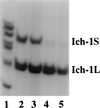Regulation of Ich-1 pre-mRNA alternative splicing and apoptosis by mammalian splicing factors
- PMID: 9689050
- PMCID: PMC21308
- DOI: 10.1073/pnas.95.16.9155
Regulation of Ich-1 pre-mRNA alternative splicing and apoptosis by mammalian splicing factors
Abstract
The importance of alternative splicing in regulating apoptosis has been suggested by findings of functionally antagonistic proteins generated by alternative splicing of several genes involved in apoptosis. Among these, Ich-1 (also named as caspase-2) encodes a member of the caspase family of proteases. Two forms of Ich-1 are produced as a result of alternative splicing: Ich-1L, which causes apoptosis, and Ich-1S, which prevents apoptosis. The precise nature of Ich-1 alternative splicing and its regulation remain unknown. Here, we show that the production of Ich-1L and Ich-1S transcripts results from alternative exclusion or inclusion of a 61-bp exon. Several splicing factors can regulate Ich-1 splicing. Serine-arginine-rich proteins SC35 and ASF/SF2 promote exon skipping, decreasing the ratio of Ich-1S to Ich-1L transcripts; whereas heterogeneous nuclear ribonucleoprotein A1 facilitates exon inclusion, increasing this ratio. Furthermore, in cultured cells, SC35 overexpression increases apoptosis; whereas heterogeneous nuclear ribonucleoprotein A1 overexpression decreases apoptosis. These results provide the first direct evidence that splicing factors can regulate Ich-1 alternative splicing and suggest that alternative splicing may be an important regulatory mechanism for apoptosis.
Figures





Similar articles
-
hnRNP A1 and the SR proteins ASF/SF2 and SC35 have antagonistic functions in splicing of beta-tropomyosin exon 6B.J Biol Chem. 2004 Sep 10;279(37):38249-59. doi: 10.1074/jbc.M405377200. Epub 2004 Jun 18. J Biol Chem. 2004. PMID: 15208309
-
Modulation of exon skipping and inclusion by heterogeneous nuclear ribonucleoprotein A1 and pre-mRNA splicing factor SF2/ASF.Mol Cell Biol. 1993 May;13(5):2993-3001. doi: 10.1128/mcb.13.5.2993-3001.1993. Mol Cell Biol. 1993. PMID: 8474457 Free PMC article.
-
Alternative splicing of the adenylyl cyclase stimulatory G-protein G alpha(s) is regulated by SF2/ASF and heterogeneous nuclear ribonucleoprotein A1 (hnRNPA1) and involves the use of an unusual TG 3'-splice Site.J Biol Chem. 2002 May 3;277(18):15241-51. doi: 10.1074/jbc.M109046200. Epub 2002 Feb 1. J Biol Chem. 2002. PMID: 11825891
-
Heterogeneous nuclear ribonucleoprotein particle A/B proteins and the control of alternative splicing of the mammalian heterogeneous nuclear ribonucleoprotein particle A1 pre-mRNA.Prog Mol Subcell Biol. 2003;31:59-88. doi: 10.1007/978-3-662-09728-1_3. Prog Mol Subcell Biol. 2003. PMID: 12494763 Review. No abstract available.
-
Splicing regulatory factors, ageing and age-related disease.Ageing Res Rev. 2017 Jul;36:165-170. doi: 10.1016/j.arr.2017.04.004. Epub 2017 Apr 26. Ageing Res Rev. 2017. PMID: 28456680 Review.
Cited by
-
Activation of alpha-tropomyosin exon 2 is regulated by the SR protein 9G8 and heterogeneous nuclear ribonucleoproteins H and F.Mol Cell Biol. 2006 Dec;26(23):8791-802. doi: 10.1128/MCB.01677-06. Epub 2006 Sep 25. Mol Cell Biol. 2006. PMID: 17000773 Free PMC article.
-
The splicing factor-associated protein, p32, regulates RNA splicing by inhibiting ASF/SF2 RNA binding and phosphorylation.EMBO J. 1999 Feb 15;18(4):1014-24. doi: 10.1093/emboj/18.4.1014. EMBO J. 1999. PMID: 10022843 Free PMC article.
-
Caspase-2 pre-mRNA alternative splicing: Identification of an intronic element containing a decoy 3' acceptor site.Proc Natl Acad Sci U S A. 2001 Jan 30;98(3):938-43. doi: 10.1073/pnas.98.3.938. Epub 2001 Jan 23. Proc Natl Acad Sci U S A. 2001. PMID: 11158574 Free PMC article.
-
An intronic signal for alternative splicing in the human genome.PLoS One. 2007 Nov 28;2(11):e1246. doi: 10.1371/journal.pone.0001246. PLoS One. 2007. PMID: 18043753 Free PMC article.
-
B-cell and plasma-cell splicing differences: a potential role in regulated immunoglobulin RNA processing.RNA. 2003 Oct;9(10):1264-73. doi: 10.1261/rna.5820103. RNA. 2003. PMID: 13130140 Free PMC article.
References
-
- Boise L H, González-García M, Postema C E, Ding L, Lindstein T, Turka L A, Mao X, Nuñez G, Thompson C B. Cell. 1993;74:597–608. - PubMed
-
- Wang L, Miura M, Bergeron L, Zhu H, Yuan J-Y. Cell. 1994;78:739–750. - PubMed
-
- Shaham S, Horvitz H R. Cell. 1996;86:201–208. - PubMed
-
- Alnemri E S, Fernandes-Alnemri T, Litwack G. J Biol Chem. 1995;270:4312–4317. - PubMed
-
- Papoff G, Cascino I, Eramo A, Starace G, Lynch D H, Ruberti G. J Immunol. 1996;156:4622–4630. - PubMed
Publication types
MeSH terms
Substances
Grants and funding
LinkOut - more resources
Full Text Sources

